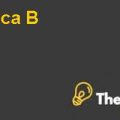
INTRODUCTION AND BACKGROUND
Cooper Industries Inc. is the manufacturer and leading producer of engines and big compressors for oil and gas extraction industry. The firm had been heavily dependent on oil and gas sector for its sales and major earning; fluctuations due to cyclic nature of industry concerned its management. Although long-term sales and earnings growth for Cooper had been above average, its stock was less attractive to investors due to higher risk and earnings volatility. Cooper’s earlier acquisitions resulted in diversity of markets but did not result in reduction of earnings volatility.To reduce the risk, management initiated an acquisition strategy to diversify its product portfolio. An acquisition criteria was established that called for acquisition of leading companies of their respective market segments.
Cooper acquired three different companies under its acquisition strategy but failed to tempt management of Nicholson File Company for a merger three years ago. However now with Nicholson in play, there was an opportunity for Cooper to acquire a controlling interest in the company. In May 1972, Robert Cizik, executive vice president of Cooper needed some answers before proceeding with appropriate course of action for this opportunity.
QUESTIONS
- Should Mr. Cizik of Cooper Industries try to gain control of Nicholson File Company in May 1972?
- What is the maximum price that Cooper can afford to pay for Nicholson and still keep the acquisition attractive from the standpoint of Cooper?
- What are the concerns and bargaining positions of each group of Nicholson stockholders? What must Cooper offer each group in order to acquire its shares?
- On the assumption that the Cooper management wants to acquire at least 80% of the outstanding Nicholson stock and to make the same offer to all stockholders, what offer must Cooper management make in terms of dollar value and the form of payment (cash, stock, debt)?
- What should Mr. Cizik recommend that the Cooper management do?
ANALYSIS
Nicholson is controlled and managed by Nicholson family. Chairman of the board, Paul Nicholson put heavy emphasis on managerial and operational independence. This was the reason of earlier re-buff of Cooper’s approach for Nicholson’s acquisition. Nicholson is an attractive takeover target due to tremendous potential for improvement despite poor sales and profit performance and low profit margins resulting from conservative financial policies. Company’s annual sales growth was only 2% compared to 6% growth rate of the industry. Nicholson’s shares were trading at historic lows and below book value of $51.25. Twenty percent of shares were held by management and Nicholson family.
CONTROL OF NICHOLSON FILE COMPANY
An important question is whether or not Nicholson meets acquisition criteria of Cooper? This criteria was based on three variables:
- Acquisition should result in leadership in the market segment of Target Company.
- Stable and broad market for products with product-line of small items, eliminating companies with dependence on few customers.
- Acquisition of leading companies only.
Cooper established a product policy of building full product-line of hand tools and its acquisitions were driven by this strategy along with the acquisition policy. Since 1967 Cooper had acquired three companies starting with the acquisition of Lufkin Rule Company that was world’s largest manufacturer of measuring rulers and tapes. This acquisition was underscored by quality product line, established distribution system and services of very knowledgeable management team. In 1967, Crescent Niagara Corporation, a well-known and high-quality manufacturer of wrenches, pliers and screwdrivers was acquired. This acquisition was important for Cooper’s product policy even though company performance had suffered a bit in recent years. Finally in 1970 Weller Electric Corporation that was world’s leading supplier of soldering tools with operations in Europe and Mexico was acquired.
Even though Nicholson’s performance in recent times was below par, it was believed that there was a lot of potential for improvement with appropriate policies that would turn its potential into healthy profits. Nicholson’s competitive advantages is a major source of its attraction. It is one of the largest domestic manufacturers of hand tools and leader in two main products. Files and rasps held 50% market share of total market of $50 million. Its saws and blades held 9% market share of $200 million, only two other companies had larger market shares in this segment. Nicholson’s overall product is of very high-quality with a broad market. In addition, Nicholson has excellent distribution system in the United States and Canada through marketing to more than two thousand hardware wholesalers who in turn sell to more than fifty thousand retailers. Nicholson had significant international presence with overseas sales to more than 137 countries through 140 local sales representatives.................
This is just a sample partial case solution. Please place the order on the website to order your own originally done case solution.
Executive President of the largest industrial companies have to decide 1) whether to buy a small hand tools company, and if so, 2) the size and shape of the acquisition package should take. "Hide
by Thomas R. Piper Source: HBS Premier Case Collection 9 pages. Publication Date: December 1, 1973. Prod. #: 274116-PDF-ENG











